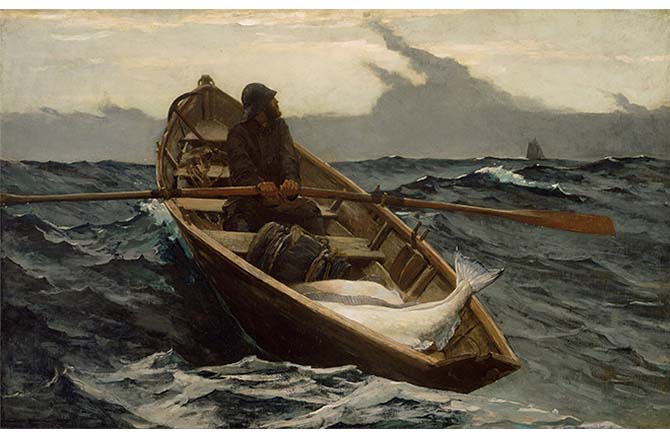Which Are The Most Famous Winslow Homer Paintings?

Winslow Homer wasn’t just a skilled watercolorist but also a skilled oil painter and sketch artist. At the time when they were produced, Winslow Homer’s paintings of maritime scenes were seen to be extremely powerful and expressive.
In contrast to other artists who were renowned for working in just one medium, Winslow Homer was famous for using a variety of art mediums. Even though Winslow Homer’s subjects were straightforward at first glance, in their most emotional moments, they broached the subject of human suffering in the context of an indifferent universe.
His skill in drawing and water coloring gives his oil paintings the thrilling immediacy of actual observation of the environment. At their most dramatic moments, his themes which sometimes appeared to be oversimplified on the surface dealt with the issue of human suffering in an indifferent environment. Check out Winslow Homer’s watercolor paintings to better understand who he really was as a painter.
Winslow Homer paintings
Famous painter Winslow Homer, a war journalist who was first sent to the front lines, captured the combat in his photographs, which included both tense battle scenes and peaceful times in the troops’ daily lives. Homer turned a few of his sketches into a collection of oil paintings, demonstrating his familiarity with the experiences of Union soldiers. Furthermore, the artist created artworks in many different themes, such as landscapes and beautiful Winslow Homer seascapes. Learn all about Winslow Homer paintings by looking at some of his most famous paintings.
The Veteran in a New Field (1865)
Winslow Homer – The Veteran in a New Field
One of painter Winslow Homer’s most well-known Civil War paintings, this one demonstrates the artist’s keen understanding of the socio-historical context in which he worked. A laborer harvests the seemingly unending wheat field with a scythe. This worker is also a veteran of the Civil War, as evidenced by the coat and flask of a Union soldier in the lower right-hand corner.
This early example of Homer’s ability to weave delicate narratives into his works was created shortly after the terrible conclusion of the war and President Abraham Lincoln’s subsequent death. However, the soldier’s working figure is depicted relatively genuinely, showing the lone figure’s arduous battle as he drags his scythe across the wheat under the scorching sun.
The Cotton Pickers (1876)
Homer traveled to Virginia during the 1870s to begin work on a series of paintings depicting the lives of people who had recently been freed from slavery but were still struggling with ingrained bigotry. Interestingly, there was a despicable plethora of racist imagery at this time. However, rather than perpetuating prejudices, he depicts serene moments in freshly freed African-Americans’ everyday lives.
This Winslow Homer watercolor painting shows two ladies standing in a sizable cotton field at harvest time, their heavy loads bearing witness to the daily labor they are put in. The two people’s enormous size and the rose-colored sunset skies, which the French Realist regularly utilized in his sympathetic depictions of rural work, symbolize Jean-François Millet’s influence.
This time of day became a metaphor for the era since Homer created this series in the last seasons of the Reconstruction Era when federal forces were anticipated to be evacuated from the South after the passing of the Compromise of 1877.
Although this picture is created in a symphony of pastel colors and set among soft white cotton filaments, it provides little to portray the women’s future. Homer instead leaves the reader’s imagination to determine the fate of the characters, as he does in this image and many other works from the time.
Mending the Nets (1882)
This is another one of the most famous Winslow Homer artworks. His attention was attracted by the elegance of the local way of life, which also gave him a new set of genre images that were only loosely connected to his expanding interest in marine subjects.
Winslow Homer – Mending the Nets
The exceptional level of detail in the piece shows Homer’s mastery of the difficult medium, especially in the hair of the people and the fishing net.
Fox Hunt (1893)
Homer’s largest painting, Fox Hunt, serves as an excellent example of the subjects he concentrated on in the 1890s when he primarily abandoned depictions of men and women working in and interacting with nature. Instead, the artist focused only on capturing the outdoors. In this picture, he portrays a famished fox fighting to survive a swarm of hungry crows.
The usual roles are reversed as the fox that regularly hunts in this area becomes the prey in this scenario. The only appearance of life is a cluster of bright red, deadly berries that stand out against the icy white snow, and the claw of the suffering creature reaches out to point to them.
Snap the Whip (1872)
This amazing Winslow Homer artwork presents a challenge to modern viewers. A row of young people strolling hand in hand and dashing over a field of grass in an amazingly brilliant Kelly green dotted with wildflowers of all hues appears to be a simple and lovely sight. On the horizon, a tiny red schoolhouse can be seen against a blue and white striped sky.
When one takes a closer look and detects signs of poverty, such as the children’s ripped and ill-fitting garments and bare feet, even Homer’s most idyllic paintings transcend nostalgia. In the years following the Civil War, children’s childhood and fate took on a unique significance in America, and these images expressed the will to rebuild and develop a stronger and more prosperous country.
Conclusion
Most people agree that Winslow Homer was among the most significant American artists of the 19th century. At a time when American artists and critics were divided over European ideals, his work fundamentally impacted the development of an American creative sensibility.
Many of his generations found encouragement in his unwavering and motivating independence. The influence of Winslow Homer persisted long into the 20th century, especially among artists who mostly shunned European-influenced abstraction trends in favor of developing an exclusively American tone in their work.











